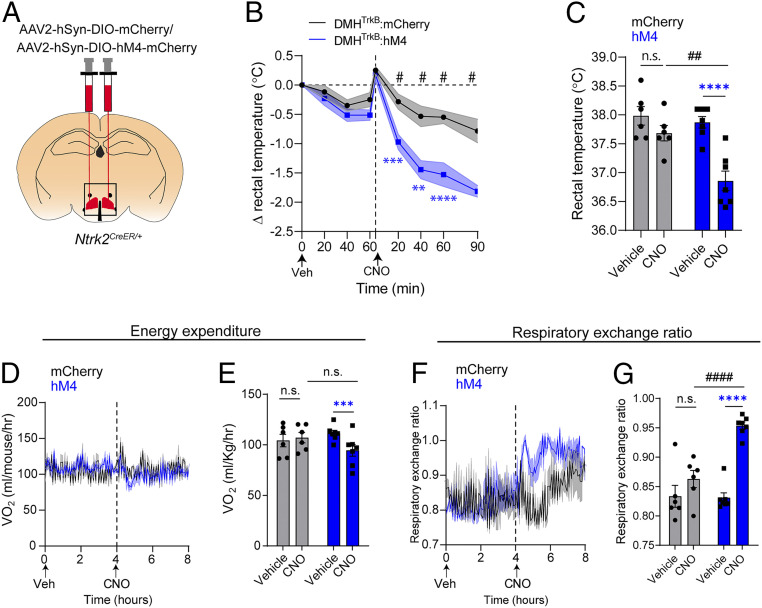Fig. 3.
DMHTrkB neurons are necessary for cold-induced thermogenesis. (A) Schematic of bilateral stereotactic delivery of AAV expressing Cre-dependent inhibitory hM4-mCherry (AAV2-hSyn-DIO-hM4-mCherry) or mCherry (AAV2-hSyn-DIO-mCherry) into the DMH of Ntrk2CreER/+. (B–G) Mice housed at 10 °C expressing either mCherry (gray, n = 6) or hM4-mCherry (blue, n = 7) in DMHTrkB neurons were treated with vehicle (Veh) or CNO during the light cycle. (B) Rectal temperature of mice following treatment with Veh (0 to 60 min) or CNO (0 to 90 min). Two-way RM ANOVA: mCherry versus hM4, F(1, 11) = 20.40, and P = 0.0009. (C) Average rectal temperatures 60 min after treatment. Two-way RM ANOVA: mCherry versus hM4, F(1, 11) = 7.577, and P = 0.0188. (D) Oxygen consumption over 4 h after treatment. Mixed-effects model: mCherry versus hM4 expression (post-CNO), F(1, 11) = 3.066, and P = 0.1078. (E) Average VO2 for the duration of the first 4 h after treatment. Two-way RM ANOVA: mCherry versus hM4 expression, F(1, 11) = 0.1502, and P = 0.7058). (F) RER over 4 h after treatment. Mixed-effects model: mCherry versus hM4 (post-CNO), F(1, 11) = 39.28, and P < 0.0001. (G) RER for the duration of the first 4 h after treatment. Two-way RM ANOVA: mCherry versus hM4, F(1, 11) = 8.633, and P = 0.0135. Values represent mean ± SEM (B–G). Sidak posttest (blue * for hM4-Veh versus hM4-CNO, black * for mCherry-Veh versus mCherry-CNO, and # for mCherry versus hM4 post-CNO: n.s. = not significant; #P < 0.05; ** and ##, P < 0.01; ***P < 0.001; **** and ####, P < 0.0001).

